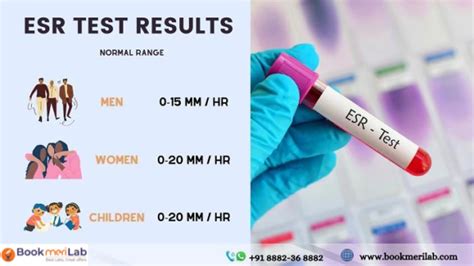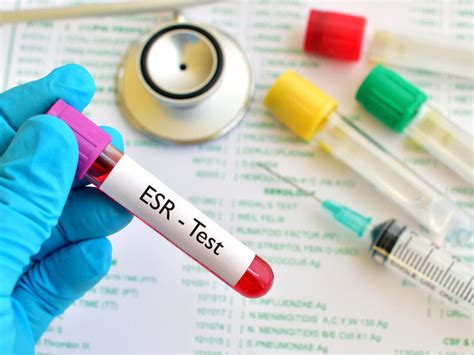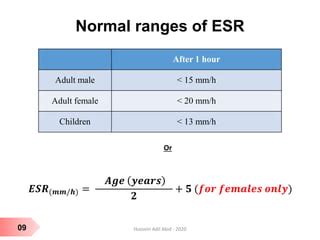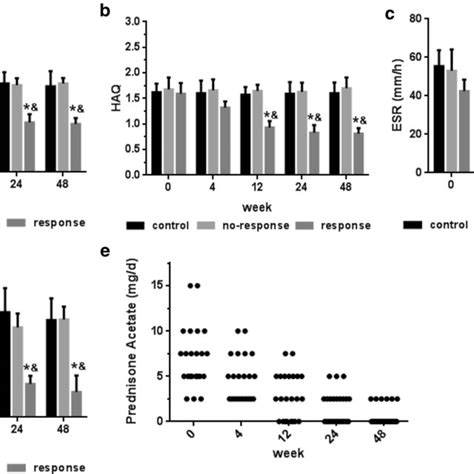Intro
Discover the normal ESR Westergren range and its significance in diagnosing inflammation, blood disorders, and sedimentation rates, with related tests and results interpretation for optimal health monitoring and disease management.
The Erythrocyte Sedimentation Rate (ESR) Westergren method is a widely used laboratory test to measure the rate at which erythrocytes (red blood cells) settle in a test tube containing a blood sample. It is a non-specific marker of inflammation and can be used to monitor various conditions, including infections, autoimmune diseases, and cancers. Understanding the normal ESR Westergren range is essential for interpreting test results and making informed decisions about patient care.
The ESR test has been in use for over a century, and its popularity stems from its simplicity, low cost, and ability to provide valuable information about the inflammatory status of a patient. The test is typically performed on a blood sample that has been treated with an anticoagulant to prevent clotting. The blood is then placed in a vertical test tube, and the rate at which the red blood cells settle to the bottom of the tube is measured over a period of one hour. The result is expressed in millimeters per hour (mm/h).
The normal ESR Westergren range varies depending on factors such as age, sex, and the laboratory performing the test. Generally, a normal ESR range is considered to be 0-20 mm/h for adults, with values below 10 mm/h being typical for healthy individuals. However, it is essential to note that the reference range may vary slightly between laboratories, and it is crucial to consult the laboratory's reference range when interpreting test results.
Understanding ESR Westergren Method

The ESR Westergren method is a widely accepted and standardized technique for measuring erythrocyte sedimentation rate. The method involves using a specific type of test tube, known as a Westergren tube, which has a uniform internal diameter and a precise calibration mark. The test tube is filled with a blood sample that has been treated with an anticoagulant, such as sodium citrate or EDTA, to prevent clotting. The tube is then placed in a vertical position, and the rate at which the red blood cells settle to the bottom of the tube is measured over a period of one hour.
Factors Affecting ESR Results
Several factors can affect ESR results, including age, sex, anemia, and technical errors during the testing process. For example, ESR values tend to increase with age, and females typically have higher ESR values than males. Anemia, which is a condition characterized by a decrease in red blood cell count or hemoglobin, can also affect ESR results. Technical errors, such as incorrect blood sampling or test tube handling, can also impact ESR results.Interpreting ESR Results

Interpreting ESR results requires careful consideration of the patient's clinical presentation, medical history, and other laboratory test results. A high ESR value may indicate the presence of an inflammatory condition, such as rheumatoid arthritis, lupus, or infection. However, a high ESR value can also be seen in other conditions, such as cancer, pregnancy, or aging. On the other hand, a low ESR value may indicate a lack of inflammation or the presence of a condition that affects red blood cell aggregation, such as sickle cell disease.
Clinical Applications of ESR
The ESR test has several clinical applications, including monitoring disease activity, detecting inflammation, and evaluating response to treatment. For example, ESR can be used to monitor disease activity in patients with rheumatoid arthritis, lupus, or other autoimmune disorders. ESR can also be used to detect inflammation in patients with suspected infections, such as pneumonia or appendicitis. Additionally, ESR can be used to evaluate response to treatment in patients with conditions such as cancer or inflammatory bowel disease.Limitations of ESR Test

While the ESR test is a valuable tool for detecting inflammation and monitoring disease activity, it has several limitations. One of the main limitations of the ESR test is its lack of specificity, which means that an elevated ESR value can be seen in a variety of conditions, making it difficult to diagnose a specific disease. Additionally, the ESR test can be influenced by technical factors, such as blood sampling and test tube handling, which can affect the accuracy of the results.
Alternatives to ESR Test
There are several alternatives to the ESR test, including the C-reactive protein (CRP) test and the plasma viscosity test. The CRP test measures the level of CRP, a protein that is produced by the liver in response to inflammation, in the blood. The plasma viscosity test measures the viscosity of the blood plasma, which can be affected by the presence of inflammation. These tests can provide more specific and sensitive measures of inflammation than the ESR test and can be used in conjunction with the ESR test to provide a more comprehensive assessment of a patient's inflammatory status.Normal ESR Westergren Range in Different Age Groups

The normal ESR Westergren range varies depending on age, with values increasing as people get older. The following are the normal ESR ranges for different age groups:
- Newborns: 0-2 mm/h
- Infants: 0-10 mm/h
- Children: 0-10 mm/h
- Adults: 0-20 mm/h
- Older adults: 0-30 mm/h
ESR in Pregnancy
During pregnancy, ESR values can increase due to the physiological changes that occur during this period. The normal ESR range during pregnancy is typically higher than in non-pregnant women, with values ranging from 15-50 mm/h. However, it is essential to note that ESR values can vary widely during pregnancy, and an elevated ESR value should be interpreted in the context of the patient's clinical presentation and other laboratory test results.ESR and Disease Activity

The ESR test can be used to monitor disease activity in patients with chronic inflammatory conditions, such as rheumatoid arthritis, lupus, or inflammatory bowel disease. An elevated ESR value can indicate increased disease activity, while a decreased ESR value can indicate improved disease control. However, it is essential to note that the ESR test is not specific for any particular disease, and the results should be interpreted in the context of the patient's clinical presentation and other laboratory test results.
ESR and Infection
The ESR test can also be used to detect inflammation in patients with suspected infections, such as pneumonia or appendicitis. An elevated ESR value can indicate the presence of an infection, while a normal ESR value can help rule out infection. However, it is essential to note that the ESR test is not specific for infection, and the results should be interpreted in the context of the patient's clinical presentation and other laboratory test results.What is the normal ESR Westergren range for adults?
+The normal ESR Westergren range for adults is typically considered to be 0-20 mm/h.
What factors can affect ESR results?
+Several factors can affect ESR results, including age, sex, anemia, and technical errors during the testing process.
What is the clinical significance of an elevated ESR value?
+An elevated ESR value can indicate the presence of an inflammatory condition, such as rheumatoid arthritis, lupus, or infection.
Can ESR be used to monitor disease activity?
+Yes, the ESR test can be used to monitor disease activity in patients with chronic inflammatory conditions, such as rheumatoid arthritis or lupus.
What are the limitations of the ESR test?
+The ESR test has several limitations, including its lack of specificity and potential for technical errors during the testing process.
In conclusion, the ESR Westergren method is a widely used laboratory test that provides valuable information about the inflammatory status of a patient. Understanding the normal ESR Westergren range and the factors that can affect ESR results is essential for interpreting test results and making informed decisions about patient care. We invite you to share your thoughts and experiences with the ESR test, and we encourage you to ask questions or seek clarification on any of the topics discussed in this article. By working together, we can improve our understanding of the ESR test and its role in promoting better health outcomes for patients.
